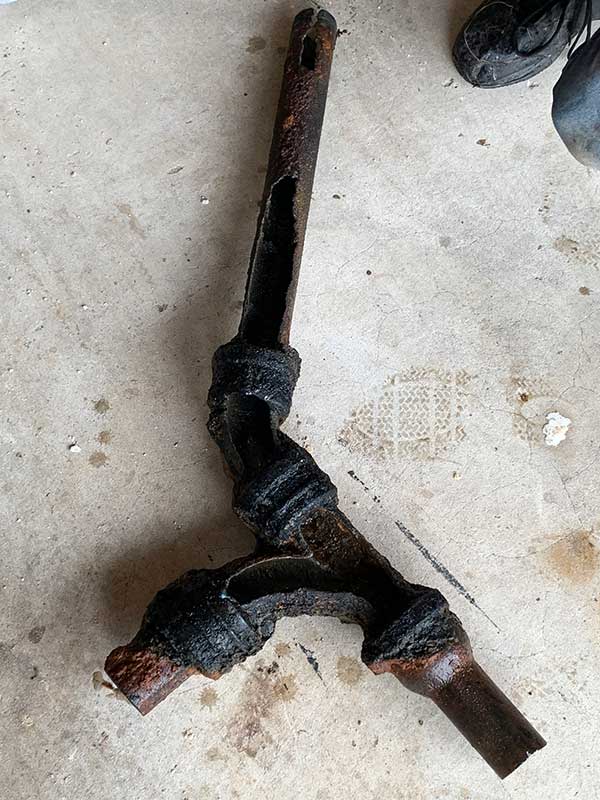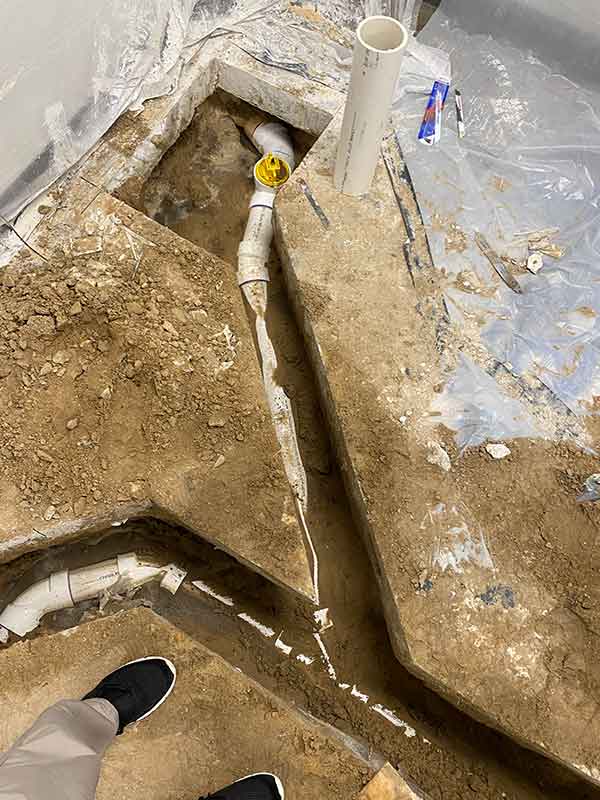Residential Cast Iron Pipe Replacement
If your home was built before 1975, or if you're buying a home built before that year, there is a good chance it will have cast iron pipes. Because cast iron is so durable, it's been used for plumbing in houses and commercial buildings for more than a hundred years.
Cast iron was meant to last between 50-100 years, it can withstand high pressure, and it won't melt or burn. Cast iron was the gold standard for pipes in the early 20th century. However, despite its dependability, structures built in the 1940s or 1950s are reaching the end of their lifespan.
The Downfall of Cast Iron Pipes
Unfortunately, there are certain disadvantages that come with using cast iron for plumbing. When these pipes carry waste from your home, hydrogen sulfide gasses are created. When they oxidize, corrosive sulfuric acid is created and this acid is hard on cast iron. The sulfuric acid will corrode and rust the pipes from the inside out.
The rust within the pipes can gather in one location and restrict water flow and affect water pressure. If there is a change and the result is low water pressure, this is indicative of a plumbing issue. Odds are, you've noticed this and have called a plumber at least once or twice to clean the corrosion from the pipes. This is a temporary fix. The corrosion will also affect the water quality, making it questionable as to whether or not your drinking water is safe.
Find Out Your Next Move!
If your home was built before 1975 we offer a free video inspection, so you can see the current state of your cast iron system.
Cast Iron Pipe Replacement Process
 The process of replacing your cast iron plumbing system requires you to follow a few basic steps:
The process of replacing your cast iron plumbing system requires you to follow a few basic steps:
- Inspect the lines to see what the issue is
- Gain access to the problem areas of plumbing lines
- Replace the plumbing line
- Repair the damage caused by gaining access to the plumbing lines
As you can see the process is just a few basic steps. However, the overall solution has facets. It is important when choosing to do a complete pipe replacement that you understand the magnitude of the project in both scope and duration. Accessing all plumbing generally requires direct access to the home's slab or sub-flooring in the kitchen and all bathrooms. Gaining access to these will typically require removing flooring, cabinets, showers, sinks, etc.
This process can be costly. When you factor in the costs associated with rebuilding all or part of your bathrooms and kitchen, it is easy to see how the costs mount up quickly. Some of this can be mitigated by the use of trenchless pipelining methods such as Cured-In-Place-Piping (CIPP).
To see how these costs compare check out our trenchless pipe repair cost calculator.
Free Video Inspection
If your home was built before 1975 we offer a free video inspection, so you can see the current state of your cast iron system.
Replacing Residential Sewer Lines
 Cast iron piping was meant to last fifty years or longer, but they will get old and start to deteriorate. There are so many factors to be considered when talking about the deterioration of cast iron pipes. There is no way to know when they will go bad, but it is certain that they will.
Cast iron piping was meant to last fifty years or longer, but they will get old and start to deteriorate. There are so many factors to be considered when talking about the deterioration of cast iron pipes. There is no way to know when they will go bad, but it is certain that they will.
Eventually, all cast iron pipes will need to be replaced. A lot of people choose to only repair what needs the most attention due to the high costs of replacing all the pipes. Repairing the major leaks and cracks will buy you some time, but it'll only fix the issue for now.
It is also important to remember that any time a cast iron pipe that is located under a concrete slab is repaired, only the sections where leaks are located are repaired by some companies. However, this won't address future issues that may occur or address any sections with minor leaks not yet detected.
The cast iron on either side of the new pipe will eventually crack, crumble, corrode, and leak as well. Because of this, it doesn't make a lot of sense to locate and repair just the parts where repair is needed. Either way, repairs or total replacement of pipes in your entire house can cost a significant amount of money, depending upon how your house is currently plumbed. Check out our Cast Iron Pipe Replacement Cost Calculator.
If your existing water line is located under the house and can be accessed from a crawlspace, this can save you money since the plumber will have an easier time getting to the plumbing. If your pipes are located under a slab, cutting through the concrete will be necessary to remove and replace the old pipes.
Why Choose Us?
The team of expert plumbers in our plumbing division, includes multiple plumbing contractors, licensed plumber, master plumbers, journeymen and other expert technicians using the latest equipment. Our team has many years of experience and offers the highest quality of service in the industry.
We are the top choice for customer service and customer satisfaction. Each project is overseen and reviewed by a licensed plumbing contractor and each job is performed to the plumbing code in the state of Florida.
Free Video Inspection
If your home was built before 1975 we offer a free video inspection, so you can see the current state of your cast iron system.
See What Our Residential Clients Say About Us

Ayana SmithI worked with APT regarding a repipe matter. Due to my work schedule, it was difficult for me to meet with them so they actually came to my office and explained what the job would entail. When they came to my home, they were very detailed, prompt, professional and made the entire process as stress free as possible. I am thankful for their services and highly recommend them should you need a repiping service.

Ginny WalkerAPT did slip lining on all our cast iron sewer pipes. We were completely satisfied with the work that was performed. Hannah, the foreman on the job was very professional and conscious. She took pride in her work and her crew. The crew did a fabulous job, cleaned up each night and were very polite and respectful. Everything was explained to us during the process. They said it would be a two day job and they were right on target. I would definitely recommend this team.

Sunkissed ChocolateThe representative that was sent to my home, I believe his name was Tony and also a gentleman name David, were so helpful during my plumbing crisis. They were very knowledgeable about the work and repairs that were required to make my house a home again.

Samuel RosarioThis company is:very professional and has a great team of people who have experience in what they do and it shows. This it the first time I used them for this job pipe lining.It is new to me but I trusted them.
GREAT JOB AND THANKS ALOT FOR YOUR SERVICE

Alexander DeveneyAPT was extremely professional. They have an abundance of knowledge and were able to diagnose my issues in a timely manner. My representative Brett was able to assist and guide me through the process. APT is one of the main reasons I was able to win my case against my home owners insurance. I couldn’t be more pleased with their staff and representatives. 10/10 would recommend to anyone in need.

Deb HenryThe team showed up a bit early. We had lost power and they graciously offered use of their generator. They protected the flooring worked steadily and cleaned up each day.

Desiree MontagnaAPT made the process super easy. I needed to get my supply line and drain pipes fixed. They made me feel at ease with such a big job. They kept me in the loop at every step. Through paper work, scheduling, permits, during the job, going over final paperwork with me, they made sure I understood the process. They took a stressful process and made it manageable.
The plumbing has never worked better. We noticed a difference the first time we used it. Our shower always backed up. The first time we used the shower after the job it was draining the correct way. Everything the touched had amazing results.

Lisa MarieI’m so thankful for Brett, Tony & all the hard workers at APT. They did everything in their power to meet our needs. They went over & beyond. Everything is working so much better. God bless and Jesus loves you!

Paula DuncanI would like to give a huge shout out to Tony D. and his team at APT, Advanced Plumbing Technology! He and his team of professionals, came to my home and without judgment, assessed The water damage to my home due to faulty cast-iron pipes. His team did not miss a beat by checking every square footage of Pipes, on the roof, within the walls, bathroom room, kitchen, and laundry room. During the process Tony sat down with me at my kitchen table and explained how it all would work. It was a bit overwhelming but he put me at ease. Highly recommend this company for your future pipe needs and plumbing repairs, assessment of damage. 😊

Carlene ReddickAPT company was pleasant to work with. They were very accessible and stay in contact with us to follow up on the processes that needed to proceed forward on the project. We worked very closely with Tony Diana and he was well knowledgeable and very informative. He did not hesitate to answer our questions and did make us feel comfortable in making all of our decisions. I would definitely recommend Applied Technology plumbing and would most likely use them in the future for our plumbing projects.

NessaAPT had to come to my house to do an inspection. They were here for 2 1/2 hours, were very thorough, and did an excellent job! They were very kind and I was very impressed. Great job APT!! Thank you 🙂

Jacob TanisTony has been great dealing with my issue I have been having. He is a very professional personable person.
